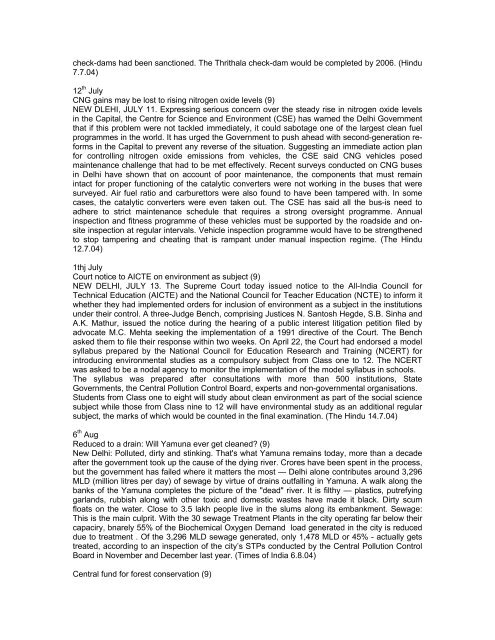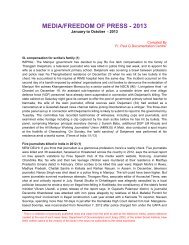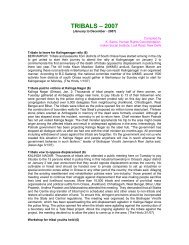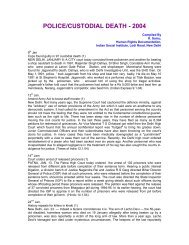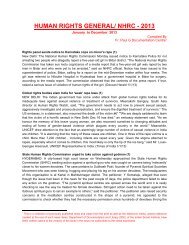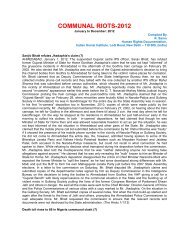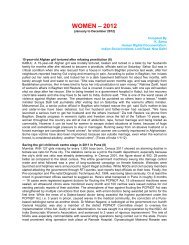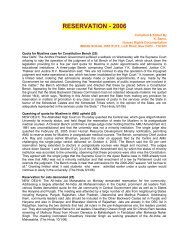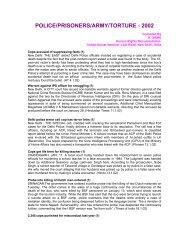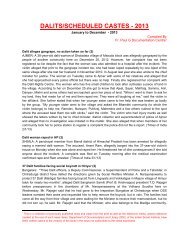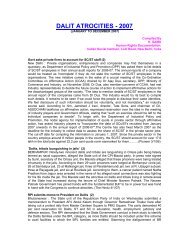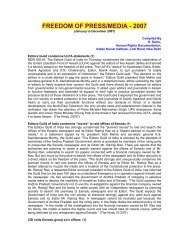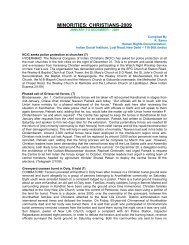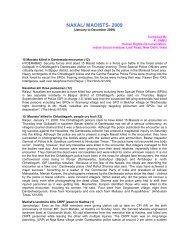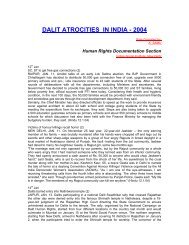ENVIRONMENT - 2004 - Indian Social Institute
ENVIRONMENT - 2004 - Indian Social Institute
ENVIRONMENT - 2004 - Indian Social Institute
Create successful ePaper yourself
Turn your PDF publications into a flip-book with our unique Google optimized e-Paper software.
check-dams had been sanctioned. The Thrithala check-dam would be completed by 2006. (Hindu<br />
7.7.04)<br />
12 th July<br />
CNG gains may be lost to rising nitrogen oxide levels (9)<br />
NEW DLEHI, JULY 11. Expressing serious concern over the steady rise in nitrogen oxide levels<br />
in the Capital, the Centre for Science and Environment (CSE) has warned the Delhi Government<br />
that if this problem were not tackled immediately, it could sabotage one of the largest clean fuel<br />
programmes in the world. It has urged the Government to push ahead with second-generation reforms<br />
in the Capital to prevent any reverse of the situation. Suggesting an immediate action plan<br />
for controlling nitrogen oxide emissions from vehicles, the CSE said CNG vehicles posed<br />
maintenance challenge that had to be met effectively. Recent surveys conducted on CNG buses<br />
in Delhi have shown that on account of poor maintenance, the components that must remain<br />
intact for proper functioning of the catalytic converters were not working in the buses that were<br />
surveyed. Air fuel ratio and carburettors were also found to have been tampered with. In some<br />
cases, the catalytic converters were even taken out. The CSE has said all the bus-is need to<br />
adhere to strict maintenance schedule that requires a strong oversight programme. Annual<br />
inspection and fitness programme of these vehicles must be supported by the roadside and onsite<br />
inspection at regular intervals. Vehicle inspection programme would have to be strengthened<br />
to stop tampering and cheating that is rampant under manual inspection regime. (The Hindu<br />
12.7.04)<br />
1thj July<br />
Court notice to AICTE on environment as subject (9)<br />
NEW DELHI, JULY 13. The Supreme Court today issued notice to the All-India Council for<br />
Technical Education (AICTE) and the National Council for Teacher Education (NCTE) to inform it<br />
whether they had implemented orders for inclusion of environment as a subject in the institutions<br />
under their control. A three-Judge Bench, comprising Justices N. Santosh Hegde, S.B. Sinha and<br />
A.K. Mathur, issued the notice during the hearing of a public interest litigation petition filed by<br />
advocate M.C. Mehta seeking the implementation of a 1991 directive of the Court. The Bench<br />
asked them to file their response within two weeks. On April 22, the Court had endorsed a model<br />
syllabus prepared by the National Council for Education Research and Training (NCERT) for<br />
introducing environmental studies as a compulsory subject from Class one to 12. The NCERT<br />
was asked to be a nodal agency to monitor the implementation of the model syllabus in schools.<br />
The syllabus was prepared after consultations with more than 500 institutions, State<br />
Governments, the Central Pollution Control Board, experts and non-governmental organisations.<br />
Students from Class one to eight will study about clean environment as part of the social science<br />
subject while those from Class nine to 12 will have environmental study as an additional regular<br />
subject, the marks of which would be counted in the final examination. (The Hindu 14.7.04)<br />
6 th Aug<br />
Reduced to a drain: Will Yamuna ever get cleaned? (9)<br />
New Delhi: Polluted, dirty and stinking. That's what Yamuna remains today, more than a decade<br />
after the government took up the cause of the dying river. Crores have been spent in the process,<br />
but the government has failed where it matters the most — Delhi alone contributes around 3,296<br />
MLD (million litres per day) of sewage by virtue of drains outfalling in Yamuna. A walk along the<br />
banks of the Yamuna completes the picture of the "dead" river. It is filthy — plastics, putrefying<br />
garlands, rubbish along with other toxic and domestic wastes have made it black. Dirty scum<br />
floats on the water. Close to 3.5 lakh people live in the slums along its embankment. Sewage:<br />
This is the main culprit. With the 30 sewage Treatment Plants in the city operating far below their<br />
capaciry, bnarely 55% of the Biochemical Oxygen Demand load generated in the city is reduced<br />
due to treatment . Of the 3,296 MLD sewage generated, only 1,478 MLD or 45% - actually gets<br />
treated, according to an inspection of the city’s STPs conducted by the Central Pollution Control<br />
Board in November and December last year. (Times of India 6.8.04)<br />
Central fund for forest conservation (9)


